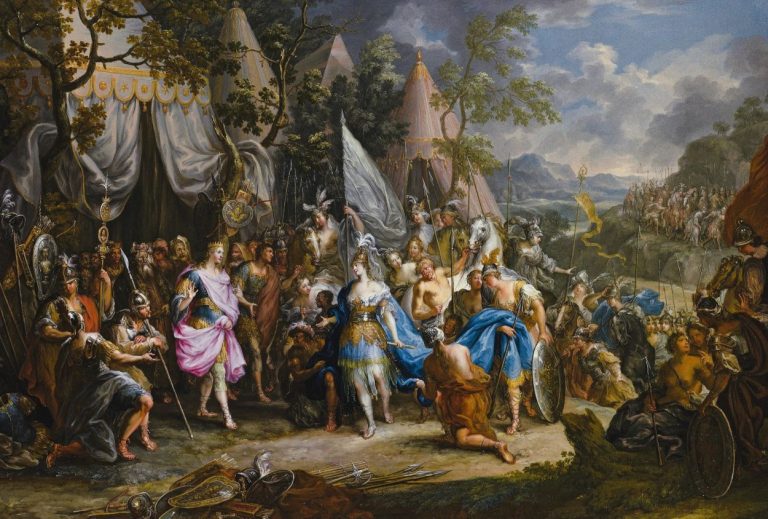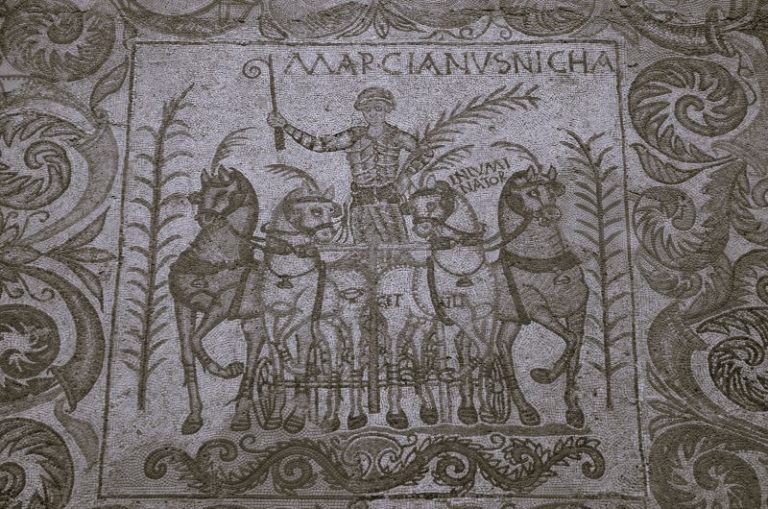
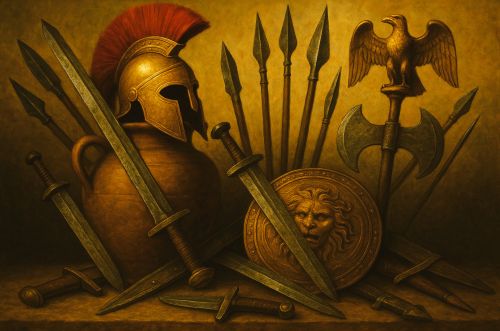
From the furnaces of Noricum to the markets of Alexandria, the trade in weapons bound together the ancient world in ways both violent and creative.

By Matthew A. McIntosh
Public Historian
Brewminate
Introduction
In a smoky workshop on the banks of the Danube, a Roman blacksmith hammers out a blade of Norican steel. Sparks leap and hiss as he plunges the metal into water drawn from the same river that carries grain, slaves, and rumors of war. The sword he shapes will not stay in Noricum; it will travel by wagon to a depot on the frontier, then by military convoy to a legion in Dacia or Syria. It is one of thousands produced that season: bought, traded, and delivered through a network that tied miners, merchants, and soldiers into a single web of iron and ambition. In that clang of metal lies an often-overlooked truth: the ancient world had its own arms industry, one without corporations or contracts, yet thriving through need, profit, and the politics of survival.
While the modern global arms trade is defined by bureaucracies and billion-dollar deals, its roots reach deep into antiquity. Long before factories or firearms, the circulation of weapons shaped economies, alliances, and empires. Spears, swords, and armor were not only tools of war but commodities of commerce, objects whose production and exchange reflected both material ingenuity and political necessity. The scale was smaller and the technology simpler, but the underlying logic was the same: demand for power drove demand for weapons.
What follows examines how that trade functioned across the ancient Mediterranean and Near Eastern worlds, from the specialized forges of Noricum to the caravan routes of Arabia and the workshops of Hellenistic Greece. It explores how the need for arms generated systems of specialized production, how long-distance trade distributed both raw materials and finished weapons, and how elites and states acted as major consumers in times of peace and war alike. It also considers the intermediaries who moved these goods, the prestige imports that symbolized status and skill, and the technological cross-pollination that followed each transaction.
In tracing these exchanges, the essay argues that the ancient arms trade was not a primitive precursor to modern industry but a distinct and sophisticated system, embedded within social hierarchies, cultural exchange, and economic life. Through the study of iron and bronze, of merchants and monarchs, we glimpse how ancient societies transformed the act of arming into an art of influence, and how commerce, like conquest, forged the world of empires.
Specialized Production

In the ancient world, weapons were both ordinary necessities and extraordinary achievements. While any competent smith could fashion a spearhead or knife, the production of high-quality arms demanded resources, expertise, and organization beyond the reach of most local craftsmen. Certain regions became renowned for their metallurgical skill, transforming weapon-making into a specialized craft supported by long-standing traditions and natural advantage. The most famous example is Noricum, a Celtic kingdom later incorporated into the Roman Empire, which produced a steel of exceptional quality prized by Roman legions. Archaeological and textual evidence suggests that Norican iron contained naturally high levels of manganese, giving it both hardness and flexibility, a metallurgical combination rare in antiquity.1 Roman authors referred to ferrum Noricum as a mark of excellence, and its export became vital to imperial arms manufacture.2
These regional specialties often evolved where geography offered the right materials. Along the Black Sea and in Anatolia, for instance, access to copper and tin deposits encouraged early bronze weapon production, while regions rich in iron ore, such as the Balkans and central Italy, became centers of ironworking during the first millennium BCE.3 By the Roman period, arms production was increasingly organized under official supervision. The fabricate, imperial arms workshops mentioned in the Notitia Dignitatum, produced standardized weapons for the legions and were strategically located near raw material sources and major transport routes.4 These state-run facilities coexisted with private workshops that filled civilian and auxiliary needs, forming a mixed economy of production.
Such specialization reflected not only technological development but also political power. States and cities able to control skilled labor and critical resources gained both military and economic advantage. In effect, the quality of a kingdom’s weapons could serve as a measure of its internal organization. The swordsmith’s forge thus became a microcosm of empire, where labor, knowledge, and nature converged to forge both metal and might.
Long-Distance Trade
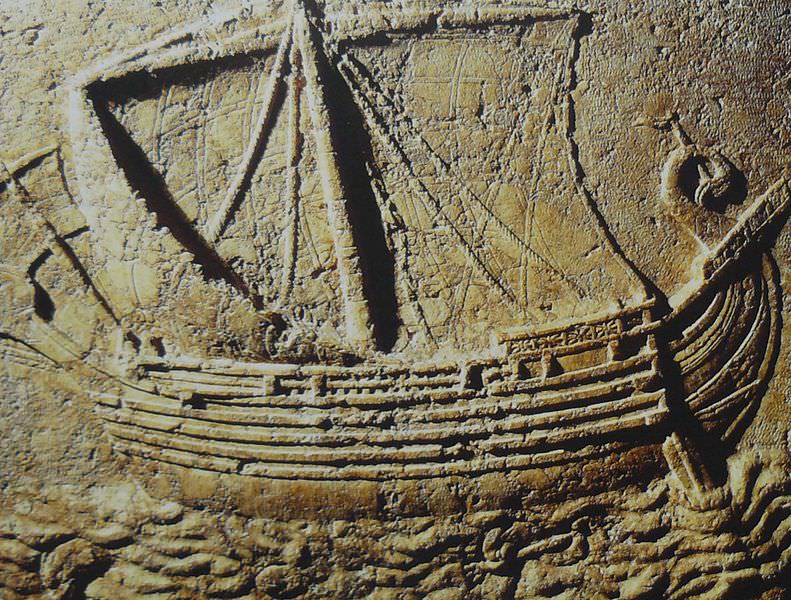
Weapons, and the materials from which they were made, rarely stayed close to their origins. In a world where armies moved across continents, so too did the metal, wood, and leather that armed them. Long-distance trade in arms was both a logistical necessity and a lucrative enterprise, bridging regions whose resources complemented one another. Iron ore from the Alps, copper from Cyprus, tin from Cornwall, and leather from North Africa fed workshops spread across the Mediterranean basin.5 Archaeological finds from shipwrecks, including cargoes of ingots and unfinished blades, attest to the scale of this commerce.6 Even when political borders shifted, these trade routes persisted, driven by a demand that transcended ethnic and imperial lines.
Roman military expansion intensified this movement. The empire’s legions required constant resupply of arms, armor, and repair materials, and the state relied on both official procurement and private trade to meet those needs. Contracts for the delivery of raw materials (iron, bronze, and hides) often spanned provinces, creating a logistical system as intricate as any modern supply chain.7 A papyrus from Egypt records transactions involving weapons and metal fittings shipped down the Nile, suggesting how standardized such trade became under imperial administration.8 The movement of goods followed both overland routes, such as those crossing the Alps, and maritime paths through ports like Ostia and Alexandria, where arms and resources could be redirected to the frontiers.
Beyond imperial structures, interregional trade networks connected cultures that shared neither language nor allegiance. Greek and Near Eastern merchants exchanged bronze and iron goods across the Aegean and Levant centuries before Rome’s ascendancy, while Phoenician traders distributed Iberian metalwork throughout the western Mediterranean.9 Even in the Bronze Age collapse of the twelfth century BCE, when empires crumbled, the archaeological record shows continuing movement of arms and materials along established maritime corridors.10 This persistence underscores that weapon trade was not simply a byproduct of empire but a durable system rooted in economic interdependence.
The distance a weapon traveled was often measured in value as much as in miles. A spear forged in the mines of Anatolia could find its way to the markets of Carthage or the garrisons of Hispania, its price inflated by the hazards of transport and the prestige of foreign craftsmanship. Long-distance arms trade thus did more than supply armies; it linked economies, spread technologies, and transformed local conflicts into engines of global exchange. In the ancient world, the road to war was also the road to wealth.
Elite and State Purchases
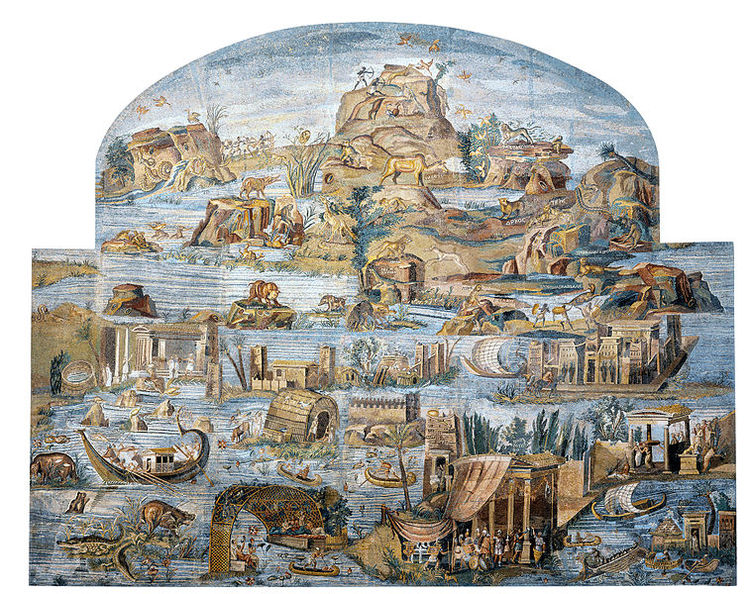
The purchase and distribution of arms were not solely commercial acts but expressions of power and legitimacy. From the palaces of Mesopotamia to the courts of Rome, rulers and military elites viewed the acquisition of weapons as both a practical necessity and a political performance. Kings and emperors needed to equip armies rapidly in times of war, and when local production fell short, they turned to broader markets. In the Roman Republic, for instance, the state often relied on private collegia fabrum, associations of craftsmen, to supply weapons and armor during large campaigns.11 This early form of military contracting blurred the lines between state procurement and private enterprise. Records of payment to armorers, along with surviving inscriptions naming individual smiths employed by the legions, reveal an organized and semi-commercial network operating under state oversight.12
In monarchies and empires where military prestige defined political strength, mass armament became a form of statecraft. Hellenistic kings, inheritors of Alexander’s legacy, maintained arsenals stocked through both domestic manufacture and foreign imports. The Ptolemies in Egypt, for example, maintained workshops in Alexandria but also imported weapons and armor from Greek city-states, ensuring their troops carried arms of the highest quality.13 In the Near East, similar dynamics prevailed: Assyrian records describe tribute in the form of metal and weaponry, suggesting a fusion of diplomacy and commerce. What could not be extracted as tribute was often purchased through intermediaries, who acted as both traders and envoys.
These bulk acquisitions stimulated entire industries. When Rome expanded its legions, or when Carthage prepared its fleets, demand rippled outward through the economies of subject and allied states. Contracts for spearheads, helmets, and shields created surges in employment and production that tied civilian economies to military cycles. In this sense, arms purchasing acted as an ancient form of economic mobilization, binding artisans, merchants, and officials into the machinery of war.14 States that could organize such systems gained an enduring advantage; those that could not depended on external suppliers, often at high cost or political risk.
The pattern reveals an economy where war was not merely destructive but generative, a force that stimulated production and exchange. Elite and state buyers stood at the center of this economy, directing the flow of goods and resources while shaping regional markets. To arm an army was to command an industry, and through that industry, to assert dominion. The sword and the coin thus became instruments of the same power: one conquered, the other sustained.
Merchants and Intermediaries

Between the workshops of craftsmen and the treasuries of kings stood a web of merchants, contractors, and agents who sustained the flow of weapons across the ancient world. These intermediaries were neither soldiers nor artisans; they were brokers of war’s material culture. In the absence of permanent armories or centralized procurement systems, their networks connected resource-rich regions with consumers hungry for arms. Phoenician and Greek traders, for instance, are known to have transported bronze goods, including weapons, throughout the Mediterranean as early as the eighth century BCE.15 While their cargoes also included pottery, dyes, and textiles, weapons and metal ingots remained among the most profitable and politically sensitive commodities they carried.
By the Hellenistic and Roman periods, these merchants had become indispensable to state logistics. The Roman state’s reliance on private suppliers, contractors known as publicani, extended beyond tax collection to encompass the acquisition and delivery of military goods. Contracts preserved in legal and literary sources suggest that such agents purchased arms from local workshops and arranged for their transport to provincial depots.16 In this sense, the publicanus functioned as both merchant and quartermaster, operating within an intricate system of accountability that linked profit to patriotism. The state benefited from their flexibility; the merchants, from imperial demand that seemed unending.
Not all intermediaries served states or empires. In frontier zones, itinerant traders often acted as arms dealers to tribes and mercenary groups, especially in periods when peace treaties restricted direct state supply. Greek merchants operating around the Black Sea, for example, sold arms to Scythian and Thracian clients, a practice simultaneously condemned and tolerated by Athenian authorities depending on political expediency.17 These exchanges not only disseminated weapons but also diffused military technologies and styles, creating hybrid forms that reflected the interconnectedness of the ancient world. A single trade voyage could spread both innovation and instability.
The presence of such merchants raises ethical and legal questions familiar even today. States alternately encouraged and curtailed the arms trade, depending on whether profit or fear dominated policy. Roman law, for example, forbade the sale of weapons to certain foreign peoples, though enforcement was inconsistent and largely opportunistic.18 In practice, commercial interest often outpaced regulation. The profitability of arms dealing in contested borderlands, regions like Numidia or Armenia, ensured a steady supply of entrepreneurs willing to risk punishment for the rewards of demand.
Ultimately, the intermediary’s role underscores how deeply commerce penetrated even the most martial spheres of ancient life. War created opportunity, and merchants transformed it into wealth. Their ships, caravans, and contracts stitched together a global economy of conflict that prefigured the modern arms industry in its logic, if not its scale. Where empires saw strategy, intermediaries saw markets, and through their hands passed not only weapons but the means by which history itself was armed.
Prized Imports

In the ancient world, as in later centuries, not all weapons were equal. Some were valued as masterpieces, objects that combined lethal function with artistic prestige. Such prized imports traveled across borders not merely as instruments of war but as symbols of craftsmanship, status, and identity. Among the most sought-after were blades forged in particular regions famed for their metallurgical excellence. The Iberian city of Toledo, even before the Roman conquest, was celebrated for producing swords of remarkable flexibility and cutting power.19 Roman officers and elite soldiers prized these weapons, commissioning them at high cost and often inscribing them with personal or regimental marks. Noricum’s steel enjoyed a similar reputation, and by the first century BCE, its export had become a cornerstone of the Roman arms economy.20
These luxury arms were more than tools; they were political statements. To wield a sword from Toledo or a cuirass from northern Italy was to display participation in a network of prestige that extended from the battlefield to the court. Archaeological finds of elaborately decorated helmets and greaves in Etruria and Campania suggest that such items were exchanged as gifts among aristocrats as well as sold in high-value markets.21 Even within the ranks of professional soldiers, imported arms functioned as markers of identity, distinguishing the wealthy from the common. A well-balanced sword from Hispania or a finely fitted Gallic shield could elevate its bearer’s standing within both military and social hierarchies.
Trade in these elite goods also stimulated technological imitation. Workshops across the Mediterranean sought to reproduce the forging methods, alloys, and designs of prestigious foreign weapons. In some cases, craftsmen successfully reverse-engineered imported arms, giving rise to hybrid styles that blended local tradition with imported innovation.22 This process created what might be called a “luxury diffusion” effect, where the aesthetic and technical qualities of top-tier imports influenced mass production and reshaped entire military cultures. Thus, imported arms became both commodities and templates for broader technological advancement.
The enduring appeal of such weapons lay in the union of beauty and brutality. They exemplified the paradox at the heart of ancient warfare: the pursuit of perfection in the instruments of destruction. Whether commissioned by kings or purchased by captains, these arms carried the aura of distant lands and exceptional skill. Their value exceeded their utility, turning commerce into culture and craftsmanship into diplomacy. Through prized imports, war became a medium of art, and the market a gallery of power.
Cultural Exchange and Adaptation

Weapons did not travel alone; they carried with them the knowledge, techniques, and cultural values of the societies that produced them. The trade in arms throughout the ancient world served as a conduit for technological innovation, as designs and methods passed from one civilization to another. The Roman gladius, for example, derived from the Celtiberian sword of Hispania, a weapon whose short, double-edged design proved devastating in close combat.23 Once adopted and refined by Roman blacksmiths, it became the standard issue for legionaries across the empire. The influence of this sword later extended northward, shaping the longer spatha of the late Roman cavalry, an evolution that, through trade and cultural contact, contributed to the development of the early medieval Viking sword.24 In this way, a single weapon design could trace a lineage from tribal Spain to imperial Rome and beyond.
Cultural exchange in arms design often followed the contours of conquest. When Greek artisans settled in Asia after Alexander’s campaigns, they brought Hellenic metalworking techniques that merged with Near Eastern traditions. This fusion produced hybrid armaments that blended Greek aesthetics with Persian practicality, ornate helmets, composite bows, and embossed armor that reflected the cosmopolitanism of the Hellenistic world.25 Similar patterns appeared centuries later under Rome, where provincial workshops absorbed local influences while maintaining imperial standards. A sword forged in Pannonia might bear stylistic features from the Danubian tribes yet conform to Roman military specifications, demonstrating the adaptability of empire to both form and function.
Trade also facilitated the spread of defensive innovations. The introduction of chain mail, or lorica hamata, to the Mediterranean is often credited to Celtic smiths, whose craftsmanship impressed the Romans during early encounters in northern Italy.26 Once adopted, this armor was replicated across the empire, with local workshops refining the technique to suit regional materials. Likewise, Eastern imports, such as scale armor from Mesopotamia and lamellar armor from Central Asia, entered Mediterranean use through trade and warfare alike, blending steppe ingenuity with Mediterranean metallurgy.27 These adaptations reveal how practical necessity overrode cultural boundaries: what worked in battle was quickly imitated, regardless of origin.
Beyond technology, the trade of weapons also transmitted ideas about power, honor, and identity. A foreign sword or shield could embody the prestige of another culture, becoming a diplomatic gift or status symbol. Rulers exchanged such items to signify alliance or dominance, embedding martial artistry within the language of politics. The Assyrians, for instance, received weapons as tribute from subject peoples, while Hellenistic monarchs displayed foreign arms in temples as trophies of conquest.28 Through such exchanges, the meaning of weaponry extended far beyond the battlefield; it became a medium of symbolic communication.
Ultimately, the cultural interchange embedded in the arms trade illuminates a deeper continuity in human history. The making and trading of weapons was not merely an economic transaction but an act of translation, transforming one people’s technology into another’s legacy. Each forge, each merchant caravan, each royal exchange contributed to a shared evolution of warfare and craftsmanship. The weapons that conquered empires also connected them, shaping a world where every blade bore the imprint of many hands.
Conclusion
From the furnaces of Noricum to the markets of Alexandria, the trade in weapons bound together the ancient world in ways both violent and creative. The exchange of arms was not simply an adjunct to warfare but a driving force of economic and cultural life. Empires rose and fell on the strength of their forges, yet behind every army marched a legion of craftsmen, merchants, and financiers who turned conflict into commerce. The production and movement of weapons, from simple spears to elaborately decorated swords, illustrate how deeply intertwined the mechanisms of war and trade truly were. They reveal an ancient economy that thrived not on peace, but on preparation.29
The story of ancient arms commerce also exposes a world where innovation traveled faster than conquest. From Celtiberian swords to chain mail from Gaul and scale armor from the East, each new design moved through channels of trade as swiftly as through the spoils of war. Political boundaries were porous where profit was concerned. A king might forbid exports to his enemies yet commission their armorers in secret; a merchant might sell to both sides of a conflict, indifferent to ideology so long as payment was secure. In these transactions lay the paradox of the ancient arms trade; it was simultaneously a source of power and of vulnerability, of unity and division.30
In the end, the weapons that armed the legions and adorned the palaces of the ancient world tell a story larger than metallurgy or military strategy. They reveal an enduring human pattern: that our tools of destruction are also instruments of exchange. Through the trade in arms, cultures met, technologies mingled, and empires connected in networks of mutual dependence. The ancient arms dealer may have worked with hammer and anvil instead of contracts and corporations, but his world was no less global than ours. What he forged was more than iron; it was the shared legacy of power, invention, and ambition that continues to shape civilization itself.31
Appendix
Footnotes
- Radomír Pleiner, Iron in Archaeology: The European Bloomery Smelters (Prague: Archeologický Ústav AV ČR, 2000), 119–122.
- Peter Connolly, Greece and Rome at War (London: Greenhill Books, 1981), 164.
- Vagn Fabritius Buchwald, Iron and Steel in Ancient Times (Copenhagen: Det Kongelige Danske Videnskabernes Selskab, 2005), 47–52.
- Hugh Elton, Warfare in Roman Europe, AD 350–425 (Oxford: Oxford University Press, 1996), 87–90.
- Andrew Sherratt and Susan Sherratt, The Growth of the Mediterranean Economy in the Early First Millennium BC (Oxford: Oxford University Press, 1993), 211–216.
- Cemal Pulak, “The Uluburun Shipwreck: An Overview,” International Journal of Nautical Archaeology 27, no. 3 (1998): 188–224.
- Peter Garnsey and Richard Saller, The Roman Empire: Economy, Society, and Culture (Berkeley: University of California Press, 1987), 45–47.
- Naphtali Lewis, Papyrus in Classical Antiquity (Oxford: Clarendon Press, 1974), 128–130.
- Maria Eugenia Aubet, The Phoenicians and the West: Politics, Colonies, and Trade (Cambridge: Cambridge University Press, 1993), 154–158.
- Eric H. Cline, 1177 B.C.: The Year Civilization Collapsed (Princeton: Princeton University Press, 2014), 77–81.
- Connolly, Greece and Rome at War, 164–165.
- M.C. Bishop and J.C.N. Coulston, Roman Military Equipment: From the Punic Wars to the Fall of Rome (Oxford: Oxbow Books, 1989), 70–73.
- Andrew Erskine, The Hellenistic World: Using Coins as Sources (Cambridge: Cambridge University Press, 2017), 112–114.
- Adrian Goldsworthy, The Roman Army at War, 100 BC–AD 200 (Oxford: Clarendon Press, 1996), 35–37.
- Aubet, The Phoenicians and the West, 154–158.
- Garnsey and Saller, The Roman Empire, 49–50.
- David Braund, Scythians and Greeks: Cultural Interactions in Scythia, Athens and the Early Roman Empire (Exeter: University of Exeter Press, 2005), 97–101.
- Clifford Ando, Imperial Ideology and Provincial Loyalty in the Roman Empire (Berkeley: University of California Press, 2000), 142–144.
- Fernando Quesada Sanz, Armas de la Hispania Prerromana (Madrid: Consejo Superior de Investigaciones Científicas, 1997), 87–89.
- Pleiner, Iron in Archaeology, 121–124.
- Connolly, Greece and Rome at War, 173–175.
- Bishop and Coulston, Roman Military Equipment, 112–114.
- Sanz, Armas de la Hispania Prerromana, 102–106.
- Ian Peirce, Swords of the Viking Age (Woodbridge: Boydell Press, 2002), 18–22.
- Andrew Erskine, The Hellenistic Stoa: Political Thought and Action (Cambridge: Cambridge University Press, 1990), 87–89.
- Bishop and Coulston, Roman Military Equipment, 62–65.
- H.R. Robinson, The Armour of Imperial Rome (London: Arms and Armour Press, 1975), 91–93.
- Nigel Spivey and Michael Squire, Panorama of the Classical World (London: Thames & Hudson, 2004), 144–147.
- Garnsey and Saller, The Roman Empire, 53–55.
- Cline, 1177 B.C., 92–94.
- Barry Cunliffe, The Ancient Celts (Oxford: Oxford University Press, 1997), 221–223.
Bibliography
- Aubet, Maria Eugenia. The Phoenicians and the West: Politics, Colonies, and Trade. Cambridge: Cambridge University Press, 1993.
- Bishop, M. C., and J. C. N. Coulston. Roman Military Equipment: From the Punic Wars to the Fall of Rome. Oxford: Oxbow Books, 1989.
- Braund, David. Scythians and Greeks: Cultural Interactions in Scythia, Athens and the Early Roman Empire. Exeter: University of Exeter Press, 2005.
- Buchwald, Vagn Fabritius. Iron and Steel in Ancient Times. Copenhagen: Det Kongelige Danske Videnskabernes Selskab, 2005.
- Cline, Eric H. 1177 B.C.: The Year Civilization Collapsed. Princeton: Princeton University Press, 2014.
- Connolly, Peter. Greece and Rome at War. London: Greenhill Books, 1981.
- Cunliffe, Barry. The Ancient Celts. Oxford: Oxford University Press, 1997.
- Elton, Hugh. Warfare in Roman Europe, AD 350–425. Oxford: Oxford University Press, 1996.
- Erskine, Andrew. The Hellenistic Stoa: Political Thought and Action. Cambridge: Cambridge University Press, 1990.
- Erskine, Andrew. The Hellenistic World: Using Coins as Sources. Cambridge: Cambridge University Press, 2017.
- Garnsey, Peter, and Richard Saller. The Roman Empire: Economy, Society, and Culture. Berkeley: University of California Press, 1987.
- Goldsworthy, Adrian. The Roman Army at War, 100 BC–AD 200. Oxford: Clarendon Press, 1996.
- Lewis, Naphtali. Papyrus in Classical Antiquity. Oxford: Clarendon Press, 1974.
- Peirce, Ian. Swords of the Viking Age. Woodbridge: Boydell Press, 2002.
- Pleiner, Radomír. Iron in Archaeology: The European Bloomery Smelters. Prague: Archeologický Ústav AV ČR, 2000.
- Pulak, Cemal. “The Uluburun Shipwreck: An Overview.” International Journal of Nautical Archaeology 27, no. 3 (1998): 188–224.
- Quesada Sanz, Fernando. Armas de la Hispania Prerromana. Madrid: Consejo Superior de Investigaciones Científicas, 1997.
- Robinson, H. R. The Armour of Imperial Rome. London: Arms and Armour Press, 1975.
- Sherratt, Andrew, and Susan Sherratt. The Growth of the Mediterranean Economy in the Early First Millennium BC. Oxford: Oxford University Press, 1993.
- Spivey, Nigel, and Michael Squire. Panorama of the Classical World. London: Thames & Hudson, 2004.
Originally published by Brewminate, 11.06.2025, under the terms of a Creative Commons Attribution-NonCommercial-NoDerivatives 4.0 International license.
